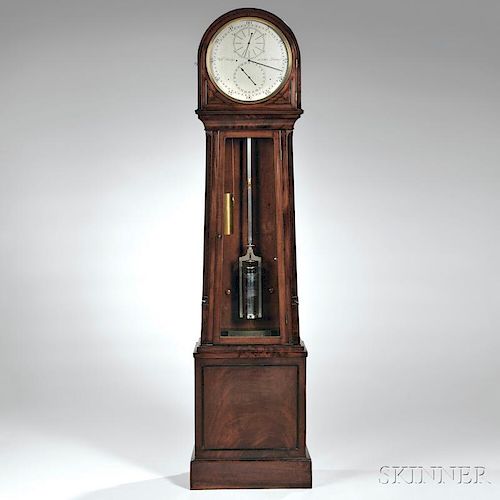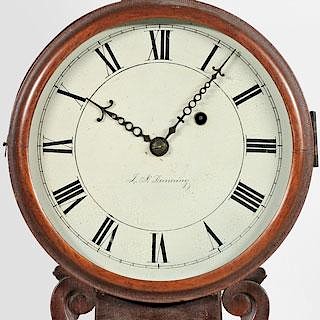William Hardy Spring Pallet Observatory Regulator
Lot 104
About Seller
Bonhams Skinner
274 Cedar Hill Street
Marlborough, MA 01752
United States
Founded over four decades ago, Bonhams Skinner offers more than 60 auctions annually. Bonhams Skinner auctions reach an international audience and showcase the unique, rare, and beautiful in dozens of categories, including the fine and decorative arts, jewelry, modern design, musical instruments, sc...Read more
Categories
Estimate:
$70,000 - $90,000
Absentee vs Live bid
Two ways to bid:
- Leave a max absentee bid and the platform will bid on your behalf up to your maximum bid during the live auction.
- Bid live during the auction and your bids will be submitted real-time to the auctioneer.
Bid Increments
| Price | Bid Increment |
|---|---|
| $0 | $10 |
| $100 | $25 |
| $500 | $50 |
| $1,000 | $100 |
| $3,000 | $250 |
| $5,000 | $500 |
| $10,000 | $1,000 |
| $30,000 | $2,500 |
| $50,000 | $5,000 |
| $100,000 | $10,000 |
| $300,000 | $25,000 |
| $500,000 | $50,000 |
| $1,000,000 | $100,000 |
About Auction
By Bonhams Skinner
Apr 25, 2015 - Apr 26, 2015
Set Reminder
2015-04-25 10:00:00
2015-04-26 10:00:00
America/New_York
Bidsquare
Bidsquare : Clocks, Watches & Scientific Instruments
https://www.bidsquare.com/auctions/skinner/clocks-watches-scientific-instruments-573
Bonhams Skinner bidsquare@bonhamsskinner.com
Bonhams Skinner bidsquare@bonhamsskinner.com
- Lot Description
William Hardy Spring Pallet Observatory Regulator, London, c. 1825, the figured mahogany case with arched hood over the substantial 12-in. engraved silvered dial signed at the center Willm. Hardy, Invt. et Fecit, London, observatory marks for the seconds chapter, 24-hour dial, outer minutes, and blued steel hands, the tapered waist section with glazed opening flanked by chamfered corners reveals the temperature-compensating pendulum with flat steel rod, sliding micro and other regulation adjustment screws, pendulum frame with mercury-filled glass jar and lid, engraved and silvered beat scale mounted to an ebony block on the case back, the lower case on a raised plinth with raised ebony trim, a brass seating board supports the heavy lacquered plate, five-pillar movement enclosed by a fitted mahogany box, with delicate high countwheels, five crossings and screw collets, spring detent escapement planted on the back plate with escape wheel mounted between jeweled chatons front and rear, all powered by a cylindrical brass weight with integral pulley and regulated by the pendulum suspended from the steel suspension spring hanging from a heavy rectangular bracket mounted across the tops of the plates, ht. 72 1/2 in.
Note: Hardy delivered his first clock, ordered by Nevil Maskelyne in April 1811, to the Old Royal Observatory in Greenwich, where it stood in the Circle Room until November 1823, when it replaced Graham's regulator as the Transit Clock. The clock performed well at Greenwich and public and private orders from all over the world quickly followed. It is thought that twenty-eight regulators were made with eighteen being recorded. It is difficult to determine, but this is probably an unrecorded example. Hardy developed the first spring pallet escapement in 1807 and is said to be the first horologist in England to make the epicycloidal cutters for wheels and pinions. In 1862, Charles Frodsham wrote that "the train and wheel work in Hardy's regulators is among the best in England, and the shape of the wheels and pinions makes the most perfect gearing I've ever seen."
Literature: For an extensive discussion of Hardy regulators and his design of a detached or spring pallet escapement and other closely related examples, please see Derek Roberts, English Precision Pendulum Clocks, pp. 83-94.
Estimate $70,000-90,000
In 1993, Roger Stevenson restored the spring pallets, and made a brass cased weight, pendulum jar and lid the rear chaton and some screws.
The absence of a condition statement does not imply that the lot is in perfect condition or completely free from wear and tear, imperfections or the effects of aging. Condition requests can be obtained via email (lot inquiry button) or by telephone to the appropriate gallery location (Boston/617.350.5400 or Marlborough/508.970.3000). Any condition statement given, as a courtesy to a client, is only an opinion and should not be treated as a statement of fact. Skinner Inc. shall have no responsibility for any error or omission. - Shipping Info
-
Please visit http://www.skinnerinc.com/services/payment-and-shipping/ for information regarding the collection of items purchased at auction.
-
- Buyer's Premium



 EUR
EUR CAD
CAD AUD
AUD GBP
GBP MXN
MXN HKD
HKD CNY
CNY MYR
MYR SEK
SEK SGD
SGD CHF
CHF THB
THB




















